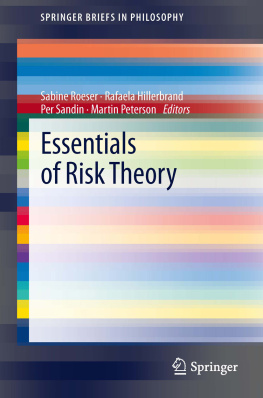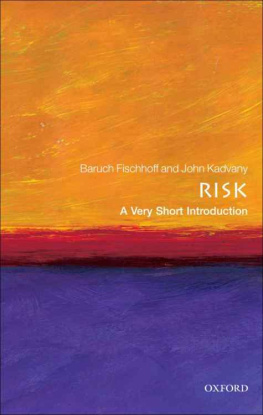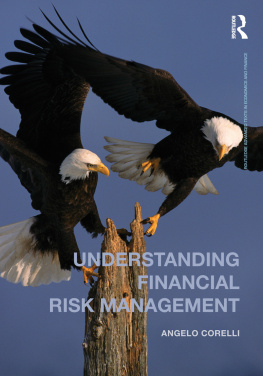Introduction
Risk is an important topic in contemporary society. People are confronted with risks from financial markets, nuclear power plants, natural disasters and privacy leaks in ICT systems, to mention just a few of a sheer endless list of areas in which uncertainty and risk of harm play an important role. It is in that sense not surprising that risk is studied in fields as diverse as mathematics and natural sciences but also psychology, economics, sociology, cultural studies, and philosophy. The topic of risk gives rise to concrete problems that require empirical investigations, but these empirical investigations need to be structured by theoretical frameworks. This handbook offers an overview of different approaches to risk theory, ranging from general issues in risk theory to risk in practice, from mathematical approaches in decision theory to empirical research of risk perception, to theories of risk ethics and to frameworks on how to arrange society in order to deal appropriately with risk.
Risk theory provides frameworks that can contribute to mitigating risks, coming to grips with uncertainty, and offering ways to organize society in such a way that the unexpected and unknown can be anticipated or at least dealt with in a reasonable and ethically acceptable way. This Book presents essential topics in risk theory. It is based on a longer book, the Handbook of Risk Theory (Springer, 2012). The Handbook of Risk Theory reflects the current state of the art in risk theory, by bringing together scholars from various disciplines who review the topic of risk from different angles. In the following sections we provide for a short overview of the contributions to the Handbook of Risk Theory.
Part 1: General Issues in Risk Theory
Theoretical reflection about risk gives rise to various general issues. What is the relation between risk research and philosophy? What can the two disciplines learn from each other? How are the concepts of risk and safety interrelated? Which different levels of uncertainty can be distinguished? Part one of the handbook discusses these general issues in risk theory.
Sven Ove Hansson: A Panorama of the Philosophy of Risk
Sven Ove Hanssons chapter provides for an overview of the contributions that different philosophical subdisciplines and risk theory can provide for each other. He starts out with discussing the potential contributions of philosophy to risk theory. These contributions concern terminological clarification, argumentation theory, and the factvalue distinction. It is philosophys core business to provide for terminological clarification. In the area of risk theory, philosophical theories can shed light on the multifaceted concepts of risk and safety. Philosophical argumentation theory can draw attention to common fallacies in reasoning about risk. In the philosophical tradition, there are intricate debates about the relationship between facts and values that can contribute to more careful and nuanced discussions about facts and values in risk analysis, for example, by making implicit value judgments explicit. These are areas in which existing philosophical theories can be applied rather straightforwardly. However, there are other issues in risk theory that give rise to new philosophical problems and require new philosophical approaches in virtually all areas of philosophy. This is due to the fact that most traditional philosophical approaches are based on deterministic assumptions. Thinking about risk and uncertainty requires radically different philosophical theories. Hence, the topic of risk can lead to new philosophical theories that are at the same time directly practically relevant, as our real-life world is one that is characterized by risk and uncertainty.
Niklas Mller: The Concepts of Risk and Safety
Niklas Mller provides for an analysis of the concepts of risk and safety. Mller distinguishes three major approaches in empirically oriented risk theory: the scientific, the psychological, and the cultural approach, respectively. Philosophical approaches connect with each of these approaches in specific ways. Mller then distinguishes between at least five common usages of the notion risk and shows how each usage can be connected to a different approach in risk research. He emphasizes the importance of distinguishing between factual and normative uses of the notion of risk. Mller continues with the question whether safety is the antonym of risk. He argues that this is not necessarily the case; for example, these words can have different connotations. Mller then discusses various ethical aspects of risk that are elaborated on in more detail in Part 5 of the handbook, on Risk Ethics. Mllers unique contribution to risk ethics is to argue that risk is a thick concept; that is, a concept that does not only have descriptive aspects that are the subject of scientific investigations, but that also has normative or evaluative aspects, which require ethical reflection. Mller discusses and rejects, on philosophical grounds, various claims by social scientists to the socially constructed nature of risk that is supposed to follow from its inherently normative nature.
Hauke Riesch:
Risk science seems to be a paradigm of interdisciplinary research: Risk unites disciplines. But every discipline seems to denote something else with the umbrella term risk. This dilemma is the starting point of Hauke Rieschs contribution on the Levels of Uncertainty. Hauke Riesch analyzes various uses of the terms risk and uncertainty. He attributes differences not so much to imperfect or sloppy use of the terms. Rather, he argues that these differences are a symptom of the fact that different scientists are interested in different aspects of risk. Therefore, there is not much point in criticizing someone for using vague or different notions of risk. Riesch conceptualizes risk as uncertainty of an event happening whose outcome may be severe. Riesch argues that concerning the uncertainty aspect of risk we can distinguish the following six questions which are not mutually independent: Why are we uncertain? Who is uncertain? How is uncertainty represented? How do people react to uncertainty? How do we understand uncertainty? What exactly are we uncertain about? Within this multidimensional map, Riesch divides the objects of uncertainty into five layers: uncertainty of the outcome, uncertainty about the parameters as well as uncertainty about the model itself, uncertainty about acknowledged inadequacies and implicitly made assumptions, and uncertainty about the unknown inadequacies. These layers relate to different concerns of different disciplines. The expert discourse commonly focuses on one of these levels, but this distorts the way people perceive particular risks, because higher level uncertainties still exist. Riesch illustrates through various case studieslottery, bad eating habits, CCS (carbon capture storage), and climate changehow all five levels of uncertainty are always present, but differently important. Rieschs multidimensional classification provides some useful information for risk communication in order to convey information on other levels of uncertainty that people find important.






